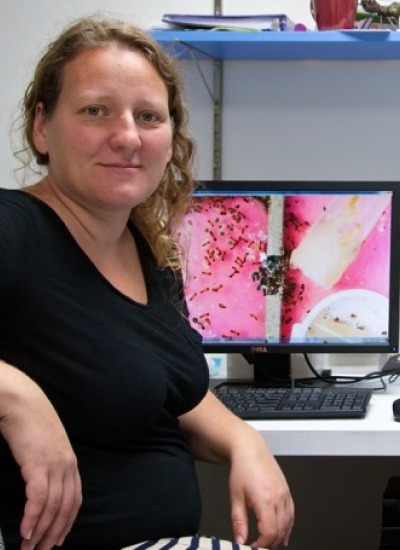Anna R Dornhaus
Publications
Abstract:
Motion and behavior analysis of social insects such as ants requires tracking many ants over time. This process is highly labor-intensive and tedious. Automatic tracking is challenging as ants often interact with one another, resulting in frequent occlusions that cause drifts in tracking. In addition, tracking many objects is computationally expensive. In this paper, we present a robust and efficient method for tracking multiple ants. We first prevent drifts by maximizing the coverage of foreground pixels at at global scale. Secondly, we improve speed by reducing markov chain length through dynamically changing the target proposal distribution for perturbed ant selection. Using a real dataset with ground truth, we demonstrate that our algorithm was able to improve the accuracy by 15% (resulting in 98% tracking accuracy) and the speed by 76%. © 2010 IEEE.
Abstract:
Floral signals are typically emitted across multiple sensory modalities, although why they are multimodal is unclear. One possible explanation is that multimodal signalling ensures that at least one signal component will be transmitted effectively under varying environmental conditions (the 'efficacy backup' hypothesis). For example, by transmitting both component A and B, a signaller can communicate under environmental conditions where transmission of component A is reduced; component B 'backs up' A. To test this hypothesis, we determined whether a floral scent could back up a floral colour signal when light levels were low. We trained nectar-foraging bumblebees to discriminate rewarding and unrewarding targets that differed in colour, scent, or both colour and scent, and then presented the targets at different levels of illumination. We measured bees' accuracy at distinguishing the two targets and their rate of visits to the trained target. Performance on both measures declined under low light when targets were unscented. The presence of scent reduced the loss of accuracy under low light, supporting the efficacy backup hypothesis, but this effect depended upon the colour of the previously rewarded target. In contrast, the presence of scent did not affect the overall rate of correct visits under low light (correct visits/foraging time). A backup mechanism that maintains accuracy, but not rate of nectar collection, does not necessarily benefit the pollinator. However, it most likely benefits the plant through reduced pollen wastage. In short, multimodal floral signals may benefit the plant by improving pollen transfer, while not benefiting the pollinator. © 2012 The Association for the Study of Animal Behaviour.
Abstract:
The return of a successful bumblebee forager stimulates nestmates to leave the nest and search for food. Here we investigate the mechanisms by which this happens. Successful Bombus terrestris foragers perform irregular runs in their nest, often lasting for several minutes. Run duration is at its maximum when food has just been discovered. Running likely serves to distribute a pheromone, since the information flow between "runners" and "recruits" can be disrupted by eliminating air exchange, while leaving other potential means of communication intact. In addition, nectar stores in the nest may be monitored continuously. A sudden influx of nectar into the nest also causes measurable increases in forager activity. The implications of bumblebee recruitment behavior for the evolution of communication in bees are discussed.
Abstract:
When an ant colony needs to find a new nest, scouts are sent out to evaluate the suitability of potential sites, particularly their size. It has been suggested that ant scouts of Leptothorax albipennis use a simple heuristic known as Buffon's needle to evaluate nest size. They do this in two stages: first laying a pheromone trail in the nest site, then, after a return to the old nest, coming back and wandering within the site assessing frequency of intersection with the pheromone trail ("two-pass" strategy). If a colony is forced to relocate from its current nest due to destruction of that nest, the time required to find a suitable new nest may be crucial. This paper details preliminary results from a computer simulation model of evaluation of nest size. The model aims to study why a "two-pass" strategy is used by ants when a "one-pass" strategy, in which the ant simultaneously lays pheromone and assesses the frequency at which it encounters its own trail, may be more time efficient. Analysis of the results indicates no clear advantage for the "two-pass" strategy, given the assumptions of the model. Possible implications of this result are discussed.
featured in PLoS Author SpotlightPMID: 23418475;PMCID: PMC3572167;Abstract:
Floral displays are under selection to both attract pollinators and deter antagonists. Here we show that a common floral trait, a nectar guide pattern, alters the behavior of bees that can act opportunistically as both pollinators and as antagonists. Generally, bees access nectar via the floral limb, transporting pollen through contact with the plant's reproductive structures; however bees sometimes extract nectar from a hole in the side of the flower that they or other floral visitors create. This behavior is called "nectar robbing" because bees may acquire the nectar without transporting pollen. We asked whether the presence of a symmetric floral nectar guide pattern on artificial flowers affected bumble bees' (Bombus impatiens) propensity to rob or access nectar "legitimately." We discovered that nectar guides made legitimate visits more efficient for bees than robbing, and increased the relative frequency of legitimate visits, compared to flowers lacking nectar guides. This study is the first to show that beyond speeding nectar discovery, a nectar guide pattern can influence bees' flower handling in a way that could benefit the plant. © 2013 Leonard et al.


